当前位置:网站首页>超级哇塞的快排,你值得学会!
超级哇塞的快排,你值得学会!
2022-07-05 14:30:00 【老鱼37】
今天我们要讲的是快速排序,非常的哇塞!
简单了解一下快排------

下面介绍快排的三个方法,未优化和优化后的快排
First----hoare版本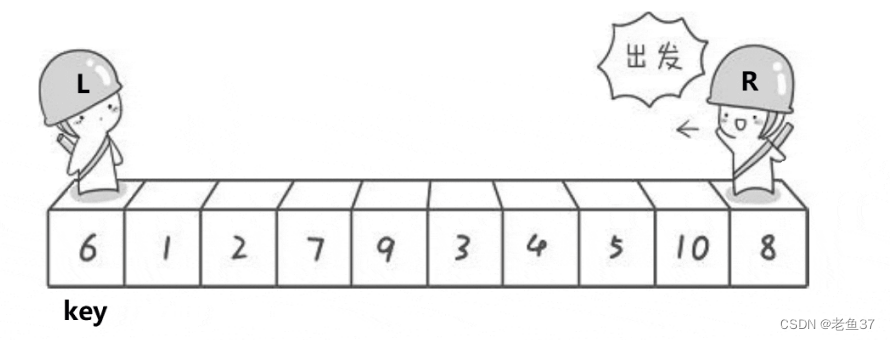
也就是说先确立的一个下标为key的值为对比值,普遍可以认为左边第一个值就key值,然后,从右边发出,寻找比key值小的数字,当R停下时,L才动,然后找到比key大的值,然后进行L、R的交换,最终他们一定会相遇,相遇的下标对应的值就将key赋值给他,然后再分而治之,
[left,key-1] key [key+1,right] 就是一样一个递归
数据结构一定要学会画图来思考问题,让问题更加地清晰明了!

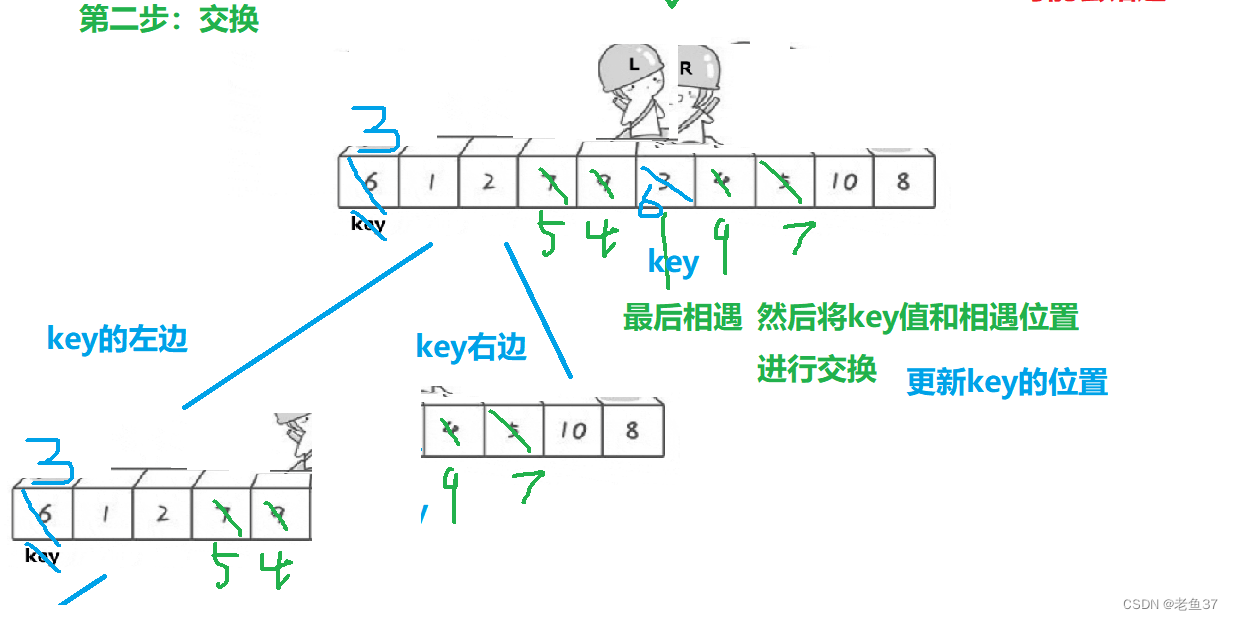
完整代码:
//hoare版本
void QuickSort(int* arr, int begin, int end)
{
//进来判断一下
if (begin >= end)
{
return;
}
int left = begin;
int right = end;
int key = left;
while (left < right)
{
//先走右边
while (left < right && arr[right] >= arr[key])
{
--right;
}
while (left < right && arr[left] <= arr[key])
{
++left;
}
//交换
Swap(&arr[left], &arr[right]);
}
//最后相遇了
Swap(&arr[key], &arr[left]);
key = left;//更新key的位置
QuickSort(arr, begin, key - 1);
QuickSort(arr, key + 1, end);
}
void PrintSort(int* arr, int len)
{
for (int i = 0; i < len; i++)
{
printf("%d ", arr[i]);
}
}
int main()
{
int arr[] = { 3,1,2,4,9,5,6};
int len = sizeof(arr) / sizeof(arr[0]);
QuickSort(arr,0, len-1);
PrintSort(arr, len);
}下面介绍另外一种方法,被大神们优化一下, 比较好理解!
2、挖坑法-------顾名思义就是有一个坑
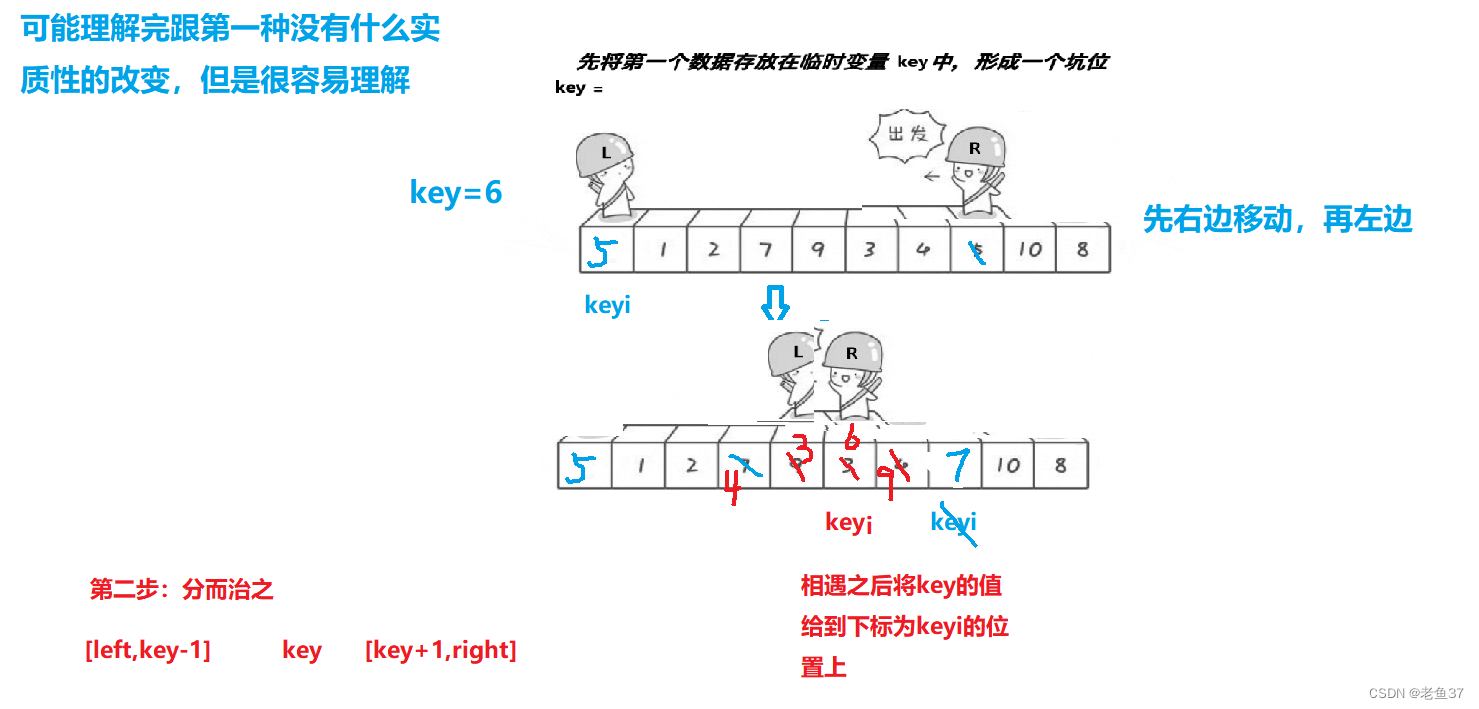
完整代码:
//挖坑法
void QuickSort(int* arr, int begin, int end)
{
if (begin >= end)
{
return;
}
int left = begin;
int right = end;
int key = arr[left];
int piti =left;//坑位
while (left < right)//控制范围
{
while (left < right && arr[right] >= key)
{
--right;
}
arr[piti] = arr[right];
piti = right;
while (left < right && arr[left] <= key)
{
++left;
}
arr[piti] = arr[left];
piti = left;
}
//还有最后相遇的一个坑位
arr[piti] = key;
QuickSort(arr, begin, piti - 1);
QuickSort(arr, piti + 1, end);
}
void PrintSort(int* arr, int len)
{
for (int i = 0; i < len; i++)
{
printf("%d ", arr[i]);
}
}
int main()
{
int arr[] = { 3,1,2,4,9,5,6};
int len = sizeof(arr) / sizeof(arr[0]);
QuickSort(arr,0, len-1);
PrintSort(arr, len);
}
第三种方法:前后指针版本

完整代码:
//前后指针版本
void QuickSort(int* arr, int begin, int end)
{
if (begin >= end)
{
return;
}
int prev = begin;
int cur = begin + 1;
int key = begin;
while (cur <= end)
{
if (arr[cur] < arr[key] && ++prev != cur)
{
Swap(&arr[cur], &arr[prev]);
}
++cur;
}
//最后只剩下一个prev
Swap(&arr[prev], &arr[begin]);
key = prev;
QuickSort(arr, begin, key - 1);
QuickSort(arr, key + 1, end);
}
void PrintSort(int* arr, int len)
{
for (int i = 0; i < len; i++)
{
printf("%d ", arr[i]);
}
}
int main()
{
int arr[] = { 3,1,2,4,9,5,6};
int len = sizeof(arr) / sizeof(arr[0]);
QuickSort(arr,0, len-1);
PrintSort(arr, len);
}相信你学会这三种快排的方法不算难事,但是那都是没进行过优化的,接下来让我们来优化一下吧!前面三种方法的时间复杂度都是O(N),在效率上并没有提升太多
优化方法—:三数取中(在前后指针版本上面改善)
影响效率的障碍就是key,要不每次key都是最小,要 不key每次都是最大,那么效率肯定就上不去,如果我们让key是区域内的middle 那么效率更上一层了,所以三数取中。
//前后指针版本
void QuickSort(int* arr, int begin, int end)
{
if (begin >= end)
{
return;
}
int prev = begin;
int cur = begin + 1;
int key = begin;
//三数取中
int mid = GetMidIndex(arr, begin, end);
Swap(&arr[key], &arr[mid]);
while (cur <= end)
{
if (arr[cur] < arr[key] && ++prev != cur)
{
Swap(&arr[cur], &arr[prev]);
}
++cur;
}
//最后只剩下一个prev
Swap(&arr[prev], &arr[begin]);
key = prev;
QuickSort(arr, begin, key - 1);
QuickSort(arr, key + 1, end);
}
优化方法二:递归到小的子区间时,可以考虑使用插入排序

因为在数据有序或者接近有序的时候,插入排序的效率非常可观,至于为什么不用希尔,堆,是因为在大数据下用他们比较快,但是接近有序的时间复杂度插入排序更胜一筹!
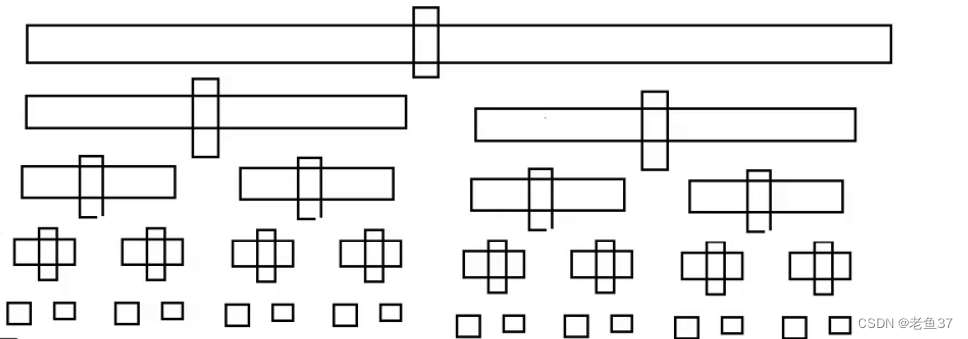
这些数据划分区域就知道最后接近有序的递归次数就占了一半,所以说非常的庞大。
区域优化代码:
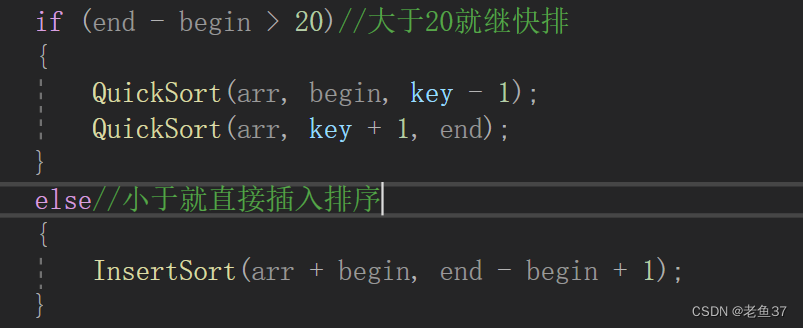
这里的插入排序的arr如果不加begin的话,那么每次都是最前面的20个数进行排序,那么无意义,arr+begin就是不同区域内的begin----end
这个优化就非常的爽了!
这些快排都是运用了递归的方式,递归也是一定的劣势,所以我们也必须要掌握非递归的方式
非递归我们运用的是栈完成快排
栈的性质是先进后出,我们可以完美地运用这个性质!
思路: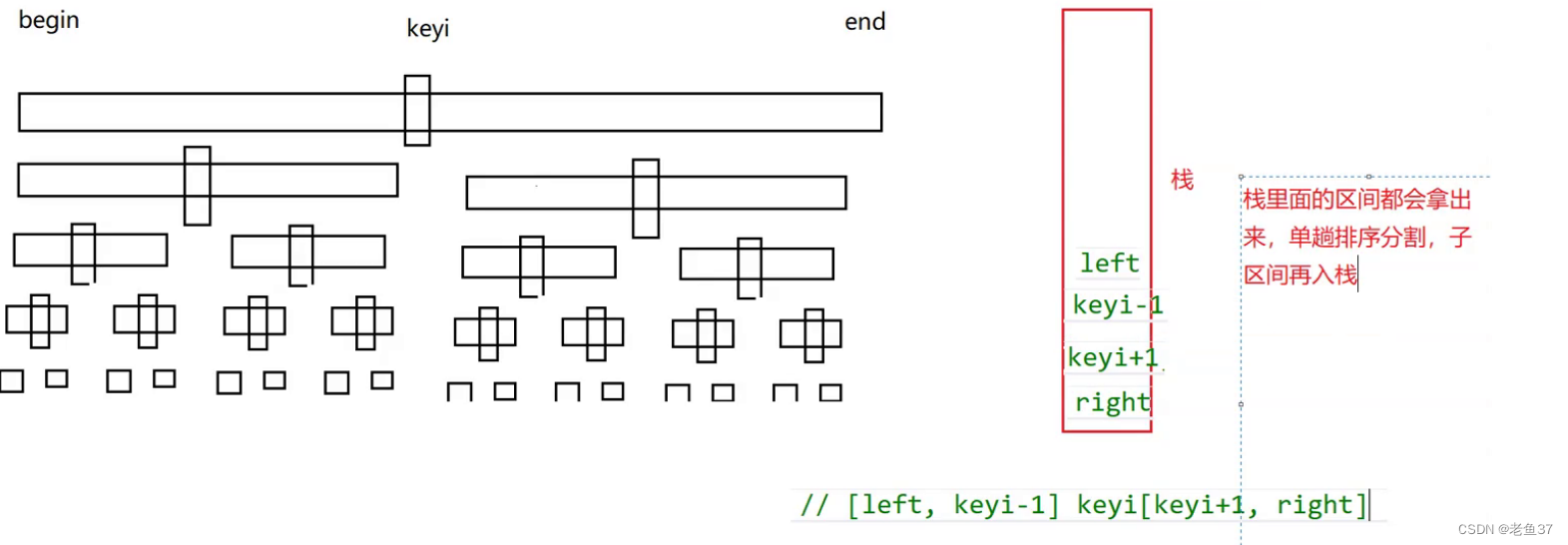
这完全就像是树的工作方式,先完成左树的排序,然后再进行右树的排序,穷尽到最后一个区域,最后再销毁一下栈就可以实现非递归的快排了
更形象一点:当然用队列也是一样的,运用好队列的性质就行好,控制好
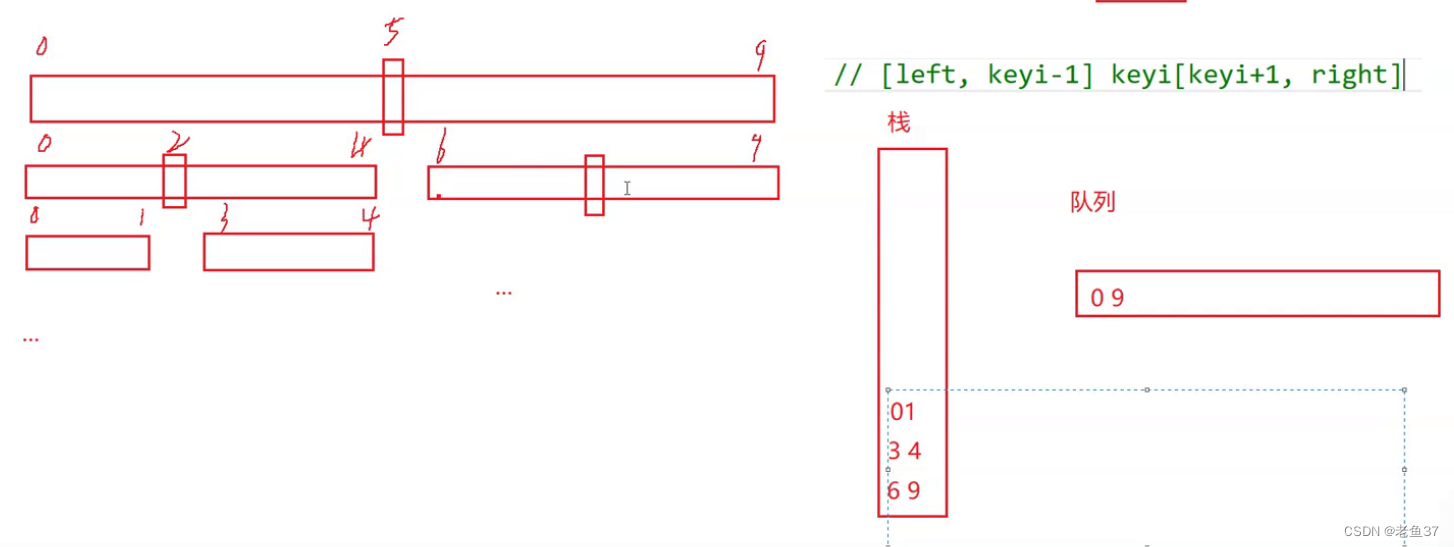
因为这是纯C所以要先手搓一个栈,到C++就不用这么麻烦了,
非递归完整代码:
//栈
typedef struct Stack
{
int* arr;
int top;
int capacity;
}Stack;
void InitStack(Stack* ps)
{
ps->arr = NULL;
ps->top = ps->capacity = 0;
}
void StackPush(Stack* ps,int x)
{
//检测是否满了
if (ps->top == ps->capacity)
{
int newcapacity = ps->capacity == 0 ? 4 : ps->capacity * 2;
int tmp = (int *)realloc(ps->arr,sizeof(int )*newcapacity);
ps->arr = tmp;
ps->capacity = newcapacity;
}
ps->arr[ps->top] = x;
ps->top++;
}
void StackPop(Stack* ps)
{
ps->top--;
}
void DestoryStack(Stack* ps)
{
ps->arr = NULL;
ps->top = ps->capacity = 0;
}
int StackTop(Stack* ps)
{
return ps->arr[ps->top-1];
}
bool StackEmpty(Stack* ps)
{
return ps->top==0;
}
//栈来实现非递归的快排
void QuickSort(int* arr, int begin, int end)
{
Stack st;
InitStack(&st);
StackPush(&st, end);
StackPush(&st, begin);
while (!StackEmpty(&st))
{
int left = StackTop(&st);
StackPop(&st);
int right = StackTop(&st);
StackPop(&st);
int keyi = QuickSort2(arr, left, right);
if (left < keyi - 1)
{
StackPush(&st, keyi - 1);
StackPush(&st, left);
}
if (keyi + 1 < right)
{
StackPush(&st, right);
StackPush(&st, keyi + 1);
}
}
DestoryStack(&st);
}
void PrintSort(int* arr, int len)
{
for (int i = 0; i < len; i++)
{
printf("%d ", arr[i]);
}
}
int main()
{
int arr[] = { 3,1,2,4,9,5,6};
int len = sizeof(arr) / sizeof(arr[0]);
QuickSort(arr,0,len-1);
PrintSort(arr, len);
}伙伴们!快来试一下吧!!
如有错误,请指出!
边栏推荐
- Chow Tai Fook fulfills the "centenary commitment" and sincerely serves to promote green environmental protection
- 微服务项目部署后,无法访问静态资源,无法访问到上传到upload中的文件,解决办法
- What about SSL certificate errors? Solutions to common SSL certificate errors in browsers
- How does redis implement multiple zones?
- 最长公共子序列 - 动态规划
- dynamic programming
- 魅族新任董事长沈子瑜:创始人黄章先生将作为魅族科技产品战略顾问
- 【NVMe2.0b 14-9】NVMe SR-IOV
- PMP考试20天能通过吗?
- Qingda KeYue rushes to the science and Innovation Board: the annual revenue is 200million, and it is proposed to raise 750million
猜你喜欢
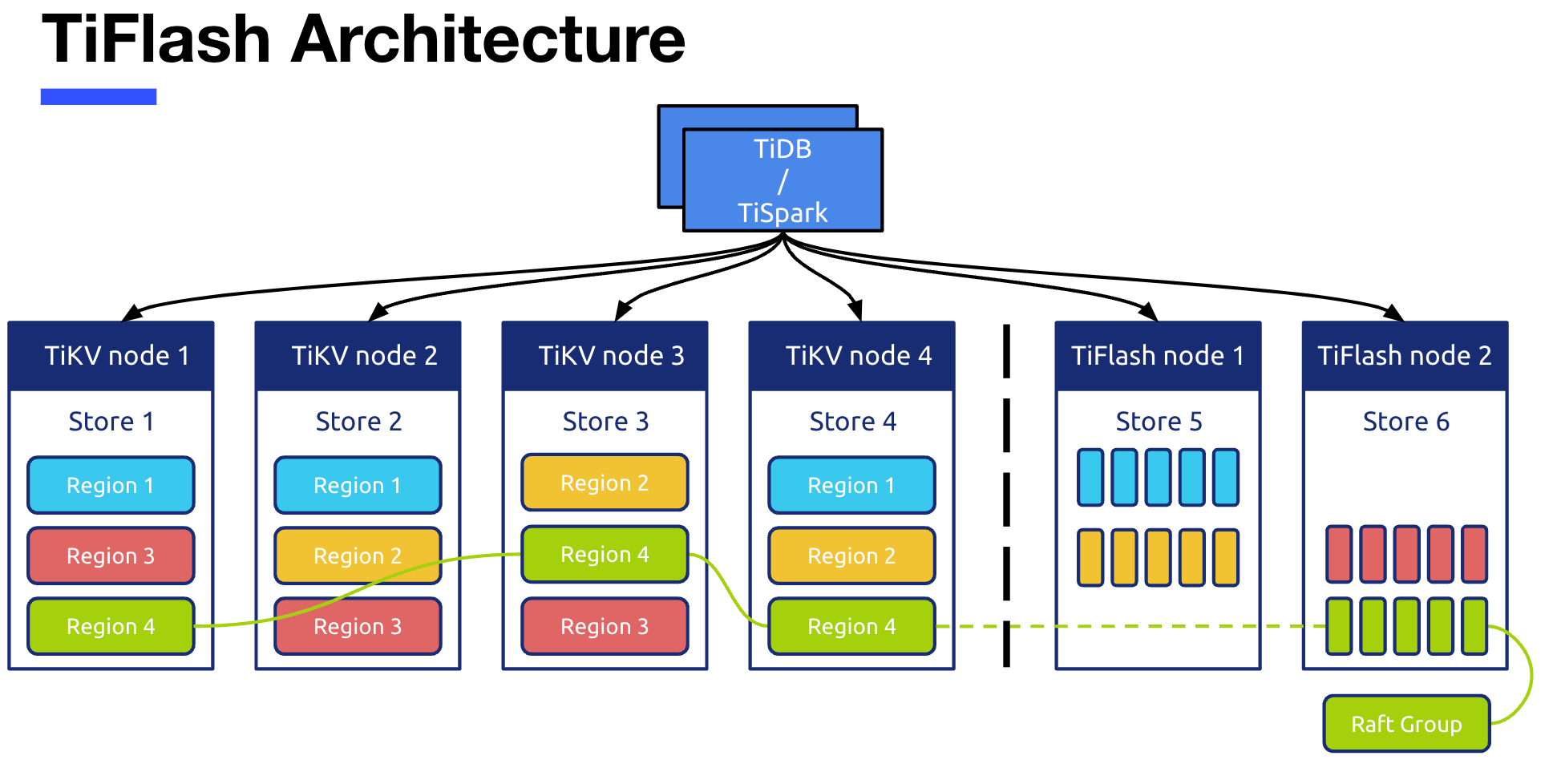
Interpretation of tiflash source code (IV) | design and implementation analysis of tiflash DDL module

Postman简介、安装、入门使用方法详细攻略!
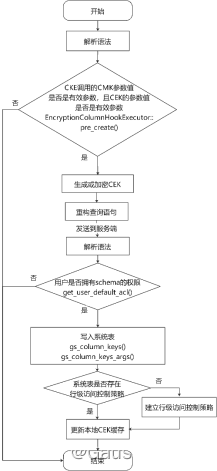
Opengauss database source code analysis series articles -- detailed explanation of dense equivalent query technology (Part 2)
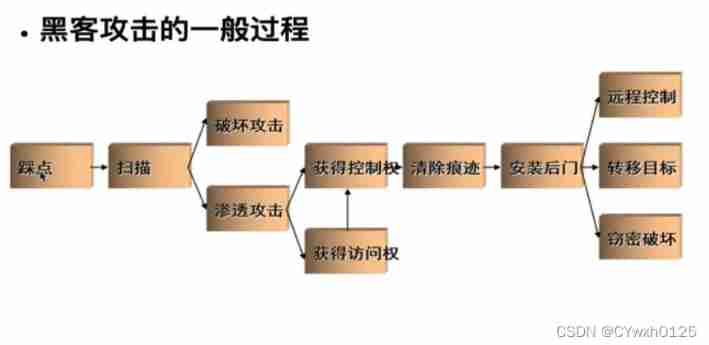
Penetration testing methodology
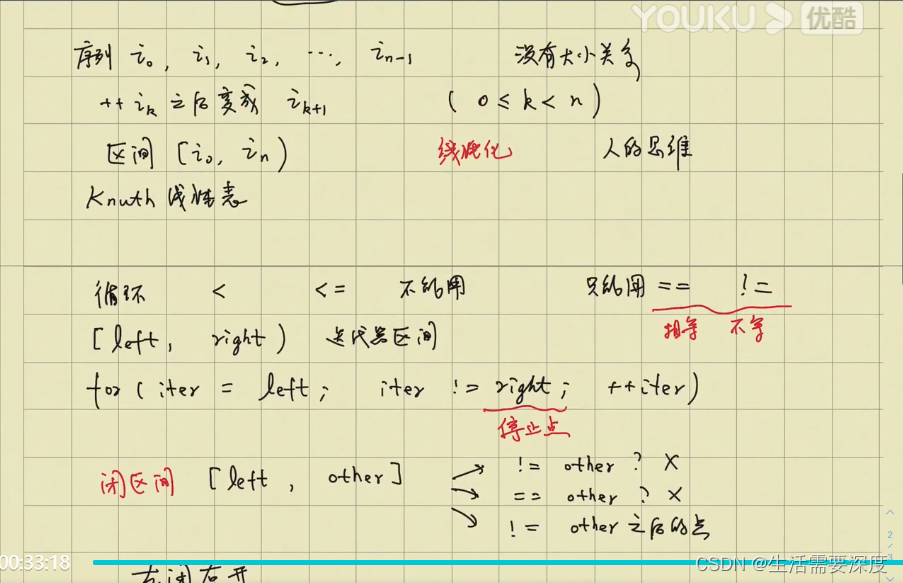
Section - left closed right open

Qingda KeYue rushes to the science and Innovation Board: the annual revenue is 200million, and it is proposed to raise 750million

How can non-technical departments participate in Devops?

直播预告|如何借助自动化工具落地DevOps(文末福利)

Shenziyu, the new chairman of Meizu: Mr. Huang Zhang, the founder, will serve as the strategic adviser of Meizu's scientific and technological products
![[summary of leetcode weekly competition] the 81st fortnight competition of leetcode (6.25)](/img/d7/f49bca8da2ce286c18508325985990.png)
[summary of leetcode weekly competition] the 81st fortnight competition of leetcode (6.25)
随机推荐
总量分析 核算方法和势方法 - 分摊分析
R language ggplot2 visual bar graph: visualize the bar graph through the two-color gradient color theme, and add label text for each bar (geom_text function)
Time to calculate cron expression based on cronsequencegenerator
Section - left closed right open
Thymeleaf th:with use of local variables
R语言dplyr包select函数、group_by函数、mutate函数、cumsum函数计算dataframe分组数据中指定数值变量的累加值、并生成累加数据列
Matrix chain multiplication dynamic programming example
直播预告|如何借助自动化工具落地DevOps(文末福利)
怎么叫一手一机的功能方式
Principle and performance analysis of lepton lossless compression
Assembly language
World Environment Day | Chow Tai Fook serves wholeheartedly to promote carbon reduction and environmental protection
Don't be unconvinced. Mobile phone function upgrade is strong
R language ggplot2 visualization: use ggplot2 to visualize the scatter diagram, and use the labs parameter to customize the X axis label text (customize X axis labels)
webRTC SDP mslabel lable
ASP.NET大型外卖订餐系统源码 (PC版+手机版+商户版)
非技术部门,如何参与 DevOps?
Postgresql 13 安装
别不服气。手机功能升级就是强
MySQL user-defined function ID number to age (supports 15 / 18 digit ID card)